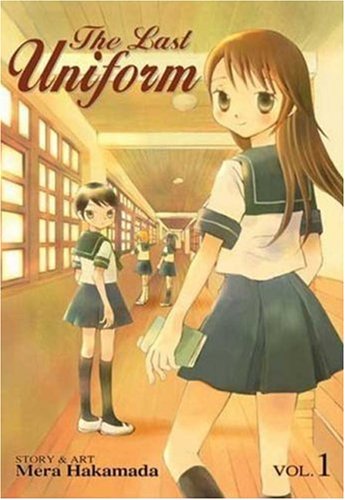The Last Uniform is a three-volume manga series by Mera Hakamada, originally published in 2005. It’s also my favorite series in the yuri genre – it has the honor of being the first lesbian manga I ever read that wasn’t exploitative or aimed unambiguously at the male gaze. This series is intended for an audience of 18-30 year old men (based on the magazine it was first serialized in), but it doesn’t contain the purposeful titillation or lesbians-merely-for-the-sake-of-hot-girls-getting-it-on that’s turned me away from a lot of yuri manga. I do have one caveat, though: the first two volumes were released in English by Seven Seas Entertainment, but apparently they didn’t sell well enough to warrant translating the third. I scoured the internet to find it in the original Japanese, and I finally was able to buy a used copy from a Japanese online bookstore. I’ve been working on translating it so I can find out what happens, but I’m only an intermediate Japanese speaker, so there’ll be no worries about spoilers in this review!
The Last Uniform (Saigo no Seifuku in Japanese) takes place at Camellia Hill High School and revolves around the lives of several girls who live in the dormitory there. The Japanese version of the manga was originally subtitled (in English) “Our Last Season,” which gives context to the translated title: this is the chronicle of the girls’ last years together at school. The four main characters – Ai, Fuuko, Tsumugi, and Beniko – share rooms, Ai with Fuuko and Tsumugi with Beniko. They’re also the series’ main couples, although their relationships develop at different rates. Ai is ostensibly the protagonist. She’s dutiful and somewhat serious, taking on the role of the cautious rule-enforcer in her relationship with Fuuko, who is reckless, goofy, and usually oblivious to other people’s feelings. When they’re assigned a new roommate, Ai becomes extremely jealous of any attention (even innocent) that Fuuko pays to the new girl. Because of this development, Ai begins to understand her true feelings for her friend.
Tsumugi and Beniko are the other central pairing, and they’re my favorite – Tsumugi is a prickly tomboy who shows she cares about her friends in roundabout ways, and Beniko is self-assured, elegant, and adored by scads of younger classmates. I consider Tsumugi’s feelings to be the most well-developed and relatable of all the characters. She knows that she’s in love with Beniko but she doesn’t know what to do about it, and she sometimes finds herself acting one way even when she knows she should be doing the opposite. On the surface, Beniko seems like the only one who can discuss her feelings without embarrassment, but it becomes clear over the early chapters that the things she says don’t actually reveal anything about her at all.
Other students who make up the supporting cast include Anzu, Ai and Fuuko’s new roommate; Kimiko, another student in the dorm; Asagi, a wealthy student who is obsessed with Beniko; and Tamami, Asagi’s friend and an amateur author of lesbian fiction. They make the love triangles into more complex polyhedrons, but the girls don’t bounce around between relationships. There’s a single intrusion of a boy who’s interested in Fuuko, but other than that, there’s really no question of who likes whom – it’s only a question of whether they’ll manage to get together.
The art is simple and unadorned, and it definitely improves over the course of the series. There are some distracting art errors early on – backwards hands and things like that – but I found it charming and expressive for the most part. The romances are handled very lightly, with hugs and kisses being as far as anything goes. There’s only a minimum of the standard yuri “But isn’t it weird for two girls to love each other?” ambivalence. I love it because of this, and because the story really is about the characters and their relationships rather than the expectation that “forbidden love” will excite the reader. That’s something I truly appreciate in manga involving lesbians, and it’s pretty rare.


Marion Delgado (@mariondelgado) says
I like this review – I did roughly the same as you (bought the 2 in english and worked on the last translating from japanese. It’s impossible not to root for Ai and Tsumugi, I think. They’re both such decent, honorable and passionate characters.
I like Hakamada’s work and her distinctive style (although the blonde girls with the dead-looking all white eyes, who look like o-bake, were a little off-putting). Have you read morishima akiko’s work? With her work I always have to draw charts to see who’s in what relationship with whom.